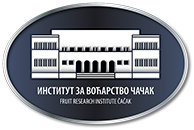| dc.description.abstract | Apical shoot tips excised from in vitro plantlets of blackberry (Rubus fruticosus L. 'Cacanska Bestrna') and cherry plum (Prunus cerasifera Ehrh.) were tested for recovery after cryopreservation using the droplet-vitrification technique. Following treatment for 30 min with a loading solution comprising 1.9 M glycerol and 0.5 M sucrose, explants were dehydrated with a highly concentrated cryoprotectant solution, so called vitrification solution. Shoot tips were dehydrated for 10,20 and 30 min at room temperature with a solution derived from the original PVS2 solution (containing 37.5% (w/v) glycerol, 15% (w/v) dimethylsulfoxide, 15% (w/v) ethylene glycol and 22.5% (w/v) sucrose) and for 60,90 and 120 min using the PVS3 solution (containing 50% (w/v) glycerol and 50% (w/v) sucrose). Explants were cooled by direct immersion in LN in 10 mu l droplets of vitrification solution placed on aluminium foil strips. Rewarming was done by direct plunging of foil strips in a preheated (37 degrees C) unloading solution (0.8 M sucrose) for 30 s, after which an equal volume of unloading solution (at room temperature) was added for further incubation for 30 min. As for regrowth of blackberry, PVS3 proved more effective than the modified PVS2, but the difference was significant (P LT 0.05) only for the shortest treatment duration. The duration of PVS3 treatment had no significant effect on regrowth of cryopreserved shoot tips (45.8-70%). By contrast, a 30-min treatment with modified PVS2 solution resulted in a significant increase in regeneration percentage (30%), as compared with a 10-min treatment with the same solution (5%). Cherry plum shoot tips were very sensitive to both vitrification solutions and growth recovery of cryopreserved samples was generally lower (5-20%) than that of blackberry explants. No significant influence of PVS treatment (both type of solution and treatment duration) on regrowth of cryopreserved shoot tips was observed with cherry plum shoot tips. Experiments performed in France and in Serbia produced similar results, thereby showing the robustness and reproducibility of the protocols developed. | en |
